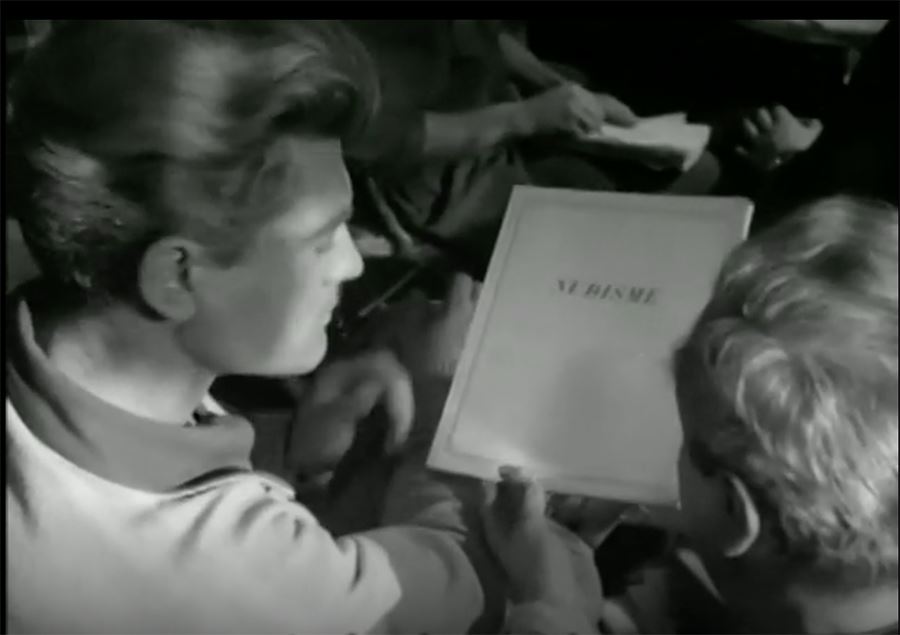“The most conceptual works are always caught up in the most material specifics.” [1] Craig Dworkin’s statement describes in a nutshell the dilemma of teaching book art over Zoom during the pandemic. I miss the informal encounters in the studios over whatever challenge the Vandercook is tossing at someone on any particular day. Demonstrating Dworkin’s haecceity of paper under a document camera is no substitute for the “material specifics” and haptic experience of actual book handling.
In my graduate seminar at Mills College, I set proof-of-concept projects for the students based on a variety of readings, including “The Logic of Substrate.” These small projects are meant to be drafts, quick studies pointing toward an idea. The students’ No Medium projects often result in their most provocative solutions, ones that can be refined and developed into full-fledged artworks. Turns out working conceptually in the realm of Duchamp’s inframince can be highly motivating.

Nudisme: Still with Jean Marais from Jean Cocteau, Orphée, 1950.
In our MFA in Book Art program, the graduate seminars act as the through line during the two years of student residency. Students take the core seminar, The Material Book, during their first semester, then follow that with three more seminars. During that first semester we meet in the Heller Room, the room in the library that houses Mills’ Special Collections. In that space there were only two books that students were not allowed to handle, the Mozart manuscript and the First Folio. Ironically, once both of those were removed from the collection, the pandemic set in and now, rather than have the entire collection accessible, students have not been able to handle anything at all. This has had a crushing impact on our focus on material studies. To help make up for this, I have been lending books from my own library for grad student study, as has my colleague Julie Chen. And through a generous donation, the students also received two books made by the artist Clarissa Sligh which they were able to thoroughly study and then include in their own libraries.
Matching students and books turns out to be a challenging experiment. What do you choose when you are grouping five books and handing them to one student, who will in turn be creating a proof-of-concept project based on their perceived linkages among the books? In my teaching I prefer to have the students find their own meaning in the books they are reading and studying. My role, as I see it, is to lay the groundwork for that exploration by deconstructing basic book operation, by asking questions and providing prompts, by guiding them to other works that share similar conceptual scaffolding and yes, by sometimes modelling interpretation. This is close reading, but with artists’ books rather than literature. To that end, I do intervene when I think that the student hasn’t pushed hard enough, and I also try to provide a strong foundation through some grounding in theoretical and historical underpinnings. This work is best done in person and with the luxury of being able to grab an example from the Heller Room shelves that helps to magnify whatever discussion has developed during the session. When, in my undergraduate class on Freedom of the Presses: Resistance and Rebellion in Print, we were suddenly locked out of the studios and library last March, I switched to having the students read and examine the digital surrogates for real artists’ books on the highly accessible Women’s Studio Workshop website. Using these surrogates, we added a discussion about what students were missing when they couldn’t handle the actual books.
Of course it’s not only faculty who are struggling. Students, even when they continue to have studio access, as our graduate students have had, contend with critiques in which slides and videos have to substitute for handling of the work. The lack of informal studio encounters means that troubleshooting and questions become formalized, and oftentimes are simply absent. Over the next three blog posts, graduate students in the Mills College MFA in Book Art will explore the acts of navigation they and other artists have had to design and sometimes struggle with over the past year. I look forward to reading what they have to say.
[1] Craig Dworkin. "The Logic of Substrate.” No Medium: MIT Press, 2013, p. 25.
Kathleen Walkup holds the Lovelace Family Endowed Chair at Mills College, where she directs the Book Art Program and teaches typography and letterpress printing, artists’ bookmaking and a graduate seminar on the material book. Her research interests include the history of women in printing and conceptual practice in artists’ books.

